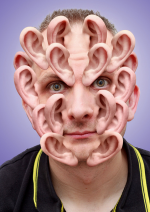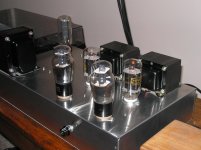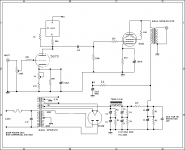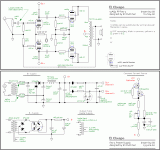Dak808 can you give me an example of say Edkors CLC, CLCLC, LCLC , Meaning a model number for each?
Sent from my SM-N910T3 using Tapatalk
The values of C capacitor and L inductor, is based on the power transformer and circuit requirements. You need specific target or voltage B+ in order to make decisions on the values to choose. People like to use PSUD which can be inputted with variables and give you an accurate final B+ for your power supply.
Dak808 can you give me an example of say Edkors CLC, CLCLC, LCLC , Meaning a model number for each?
DAK was referring to the 'filter' section that comes after the rectifier(s).
C= capacitor
L=choke
R=resistor
So CLC would be a capacitor input filter with a choke
LCLC would be a choke input filter, etc..
If you don't have Duncan Amps PSUD software (for Windows) download it and play around with some power supply ideas- you'll find it useful.
EDIT: I thought DAK would be right here with the answer! I gotta type faster..... 🙂
There are other variants CRCRC, LCRC etc.....different voltage outputs with the same PT and rectifier...
Alex Kitic (RH84 designer) has a couple of different power supplies on the RH84 page:
RH Amplifiers: RH84 amplifier - revision 2
Both CLC and LCLC there....
RH Amplifiers: RH84 amplifier - revision 2
Both CLC and LCLC there....
DAK808 thanks for the reply, no I don't realize as I am a NOOB with a capital N.You realize that the DECware zen outputs less than 2watts from its triode connected sv83 power tube. My Altec 19 speakers are about 100db efficiency, and i can easily hear the difference between 2 and 4 watts, 4 and 8 watts. The higher power manifests as more impact and more definition even at the same sound pressure levels.
Since the DEC uses no feedback they need to use triode mode for the power tubes to achieve adequate speaker damping. cheers.
But I do appreciate your input very much, and the issue you raise with the Decware does concern me. Do you have a schematic for the RH84that you would be willing to share or paint me to? Never mind I see you already posted it. " I found that the 4 watts from the el84 is adequate but 6 to7 watts from the same circuit at higher voltages is better. And the better the output transformers the better your sound quality. The better your power supply, the better sound quality. CLC is the minimum, and CLCLC is better, and if you can manage a high voltage power trans then LCLC has better voltage regulation which is the best sounding all things being equal." I see you don't have any problem spending my money 😀 Thanks I will look into this.
Dan,
You said SET. At your $300 budget point, mimicing the DECWARE SE84, as shown by Jeff Yourison is your best bet. The RH84 is single ended, BUT it's full pentode mode, with short loop NFB.
BTW, best open loop linearity with full pentode mode requires regulated screen grid B+. Can you say more complications and cost?
You said SET. At your $300 budget point, mimicing the DECWARE SE84, as shown by Jeff Yourison is your best bet. The RH84 is single ended, BUT it's full pentode mode, with short loop NFB.
BTW, best open loop linearity with full pentode mode requires regulated screen grid B+. Can you say more complications and cost?
Danconway327,
Here is the 12AB5 amp I mentioned earlier. Eli intended this to be a cheap SE84 knockoff. It sounds very detailed and the trioded 12AB5s produce good bass and treble. This one is capable of higher volumes than the 6BM8.
Note: The amp schematic says "Draft" but it is the final build I implemented.
Thank Jeff I will have a look at this, per Eli's recommendation.
Why use a 12 watt tube (12AB5) when there are cheap 24 watt tubes with better triode curves?
Also all tubes produce good bass and treble, it's how you use them 😉
Also all tubes produce good bass and treble, it's how you use them 😉
Why use a 12 watt tube (12AB5) when there are cheap 24 watt tubes with better triode curves?
Also all tubes produce good bass and treble, it's how you use them 😉
I'm all ears go ahead and let me know your thoughts, with a schematic and build to back it up please. I am a noob so be gentle please. And thank you!
An externally hosted image should be here but it was not working when we last tested it.
Attachments
Last edited:
FM Please tell me I should do a push pull amp as opposed to a set for my cornwalls?
Last edited by a moderator:
Right, i neglected to mention the Dropping resistor, or R. I was just thinking about my builds where i almost exclusively use inductors instead of a resistor for voltage dropping.There are other variants CRCRC, LCRC etc.....different voltage outputs with the same PT and rectifier...
FM Please tell me I should do a push pull amp as opposed to a set for my cornwalls?
Well I am not sure......I was recommding a SET amp.
But if you are interested in a push pull amp you we can go that route. A good friend of mine has Cornwall II's and I have heard all sorts of different amps through them. IMHO with these sorts of speakers you don't need lots of power and which is why I mainly run a SET with my La Scala's. I have a 45 DHT amp and a 6HJ5 triode amp, I love both but have been using the 6HJ5 a lot lately. It is a great amp, especially for the money.
My apologies, I thought that the Edcor XPWR172 was a push pull transformer.😕
Last edited by a moderator:
I am not really looking for a push pull I was confused about the power supply fm suggested. Lets carry on with S.E.T. FTW!
Another thing to consider when making suggestions for me {WHICH I REALLY APPRECIATE ALL OF THE INPUT BTW} 😀 is that I need a design that has been used before by enough people that I can get some help and feedback when it comes to building and tweaking it as I am a total N
 B when it comes to tubes. So please keep that in mine and thank you very much.
B when it comes to tubes. So please keep that in mine and thank you very much.

 B when it comes to tubes. So please keep that in mine and thank you very much.
B when it comes to tubes. So please keep that in mine and thank you very much.- Status
- Not open for further replies.
- Home
- Amplifiers
- Tubes / Valves
- Help with Budget SET amp for Klipsch Cornwalls



